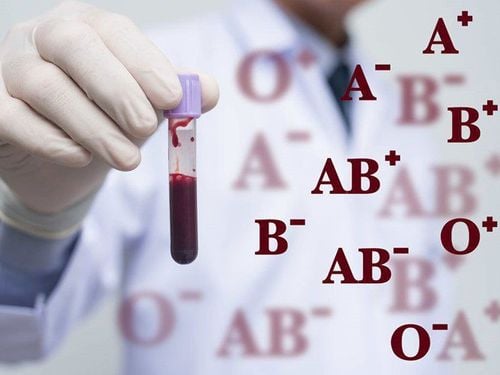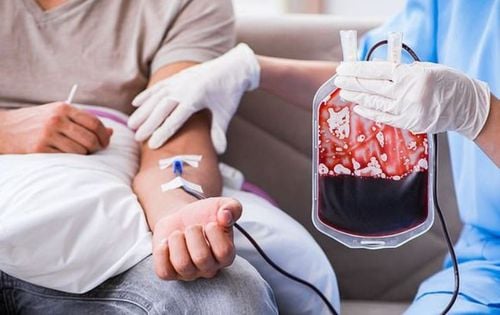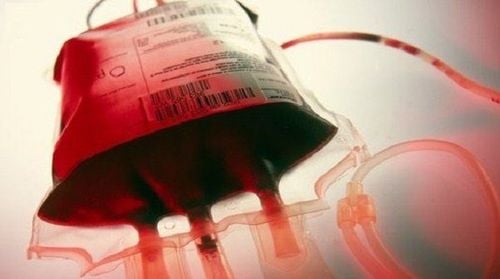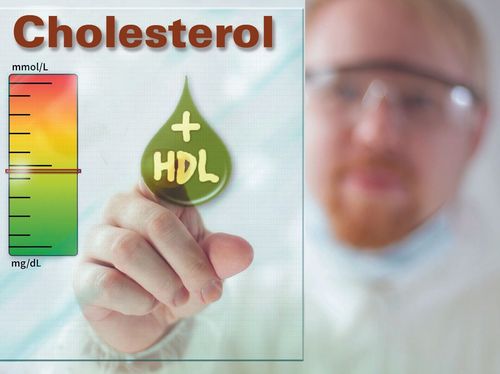This is an automatically translated article.
All blood products used today are obtained from donors. Accordingly, the indication for blood transfusion is always to weigh the benefits and risks for safe and effective use of blood.1. How to use blood products: Red blood cells
1.1. Whole Blood Whole Blood is packaged as 250ml per unit with a storage time under standard conditions of approximately 35 days.Indications to use whole blood compared to erythrocytes are quite limited. Therefore, whole blood is rarely used. This form of preparation is used in cases of acute blood loss causing hypovolemia, when performing blood exchange procedures or replacing erythrocytes when not available or lacking.
Do not use whole blood in case of recompensation when chronic anemia or heart failure, circulatory overload is new.
Prior to whole blood transfusion, always check the appropriate ABO and Rhesus systems. Whole blood removed from the refrigerator should be transfused rapidly within 30 minutes and should be completed within 4 hours.
1.2. Sedimented RBCs Red blood cells are packaged as 250ml, 350ml or 450ml per unit with a shelf life of approximately 35 days under standard conditions. The mean hemoglobin (Hct) ratio of erythrocytes is 65 to 75%.
Indications for erythrocyte sedimentation are the most widely used in blood products. Accordingly, erythrocyte sedimentation is used when:
Replace red blood cells for patients with severe anemia with Hb below 6 to 8 g/dL; can be used with colloidal solution in case of acute blood loss. Patients with acute leukemia should maintain Hb above 8 g/dL for patients in remission, in stable patients, or in patients who have received treatment if there are no clinical abnormalities. Hb should be maintained above 9 g/dL in patients requiring chemotherapy, chemotherapy-induced myelosuppression, or concomitant cardiopulmonary disease. Thalassemia patients need to maintain Hb above 9.5 g/dL in the first years of life to ensure the development of the body. Before infusion of erythrocytes or blood products in general, appropriate testing for the ABO and Rhesus systems should be performed. Red blood cells removed from the refrigerator should be transfused rapidly within 30 minutes and should be completed within 4 hours.
In adults, each unit of blood on average raises Hb by 1 g/dL or Hct by 3%. However, since ideal blood counts vary with age, the average erythrocyte sedimentation volume required to transfuse is about 10 to 20 ml/kg body weight. If the patient has a pre-existing chronic anemia, the erythrocyte sedimentation rate should be less than 5 ml/kg body weight concurrently with the infusion lasting more than 4 hours.
If a rapid infusion of erythrocytes is possible due to the critical condition, an additional 0.9% sodium chloride infusion line running parallel to the transfusion line is required. The volume of 0.9% NaCl required is equivalent to the volume of blood.
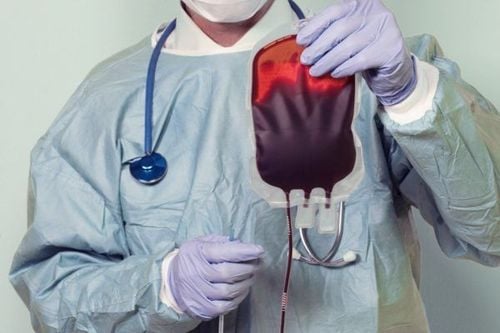
Cần lưu ý thực hiện xét nghiệm phù hợp hệ ABO và Rhésus trước khi truyền các chế phẩm từ máu
How to use leukocyte-poor red blood cells as well as whole blood. In the absence of leukocyte-poor red blood cells, a leukocyte filter can be used.
1.4. Washed erythrocytes Washed erythrocytes are a type of blood product containing only red blood cells after being decanted through physiological saline solution. The goal of erythrocyte washing is to reduce plasma protein contamination. This is the smallest packaged red blood cell preparation with 100ml per unit. The mean hemoglobin (Hct) ratio of washed red blood cells is 65 to 75%.
Indication for the use of washed red blood cells will be made when it is suspected in the plasma that there are antibodies that can harm the recipient. In which, the most common indication is when needing blood transfusion for patients with IgA deficiency, paroxysmal nocturnal hemoglobinuria and prevention of patients with reactions to plasma components.
It is important to note that washed red blood cells must be used within 24 hours of washing.
2. How to use blood products from platelets
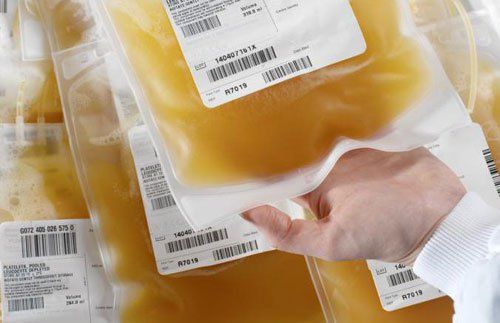
Tiểu cầu cũng được thu thập từ máu toàn phần của người hiến máu hay từ người chỉ hiến tiểu cầu (các thành phần khác sẽ được truyền trả lại ngay trong lúc hiến máu)
Platelet concentrate can be used for 24 hours after extraction and for up to 5 days under continuous shaking at room temperature 20 to 24°C to avoid adhesion.
Indications for the use of platelets are as follows:
Treatment of bleeding due to thrombocytopenia in bone marrow failure, blood transfusion or platelet dysfunction Prevention of bleeding due to thrombocytopenia Leukemia patients Acute or stable marrow transplantation with platelet count less than 10,000uL or less than 20,000uL with bleeding Prophylactic platelet transfusion for patients with fever, sepsis, previous bleeding, high white blood cell count, severe mucositis, disease Hemostasis, initiation of chemotherapy, and rapid platelet decline when platelets are below 20,000uL. In patients requiring surgical procedures, minor surgery, need to raise platelets above 50,000uL. In patients requiring major surgery such as neurosurgery, platelets should be raised above 100,000uL. Note that there is no indication for platelet transfusion when suffering from diseases that destroy platelets due to acquired platelets, taking antiplatelet drugs... In addition, platelet transfusion will be less effective when the patient has fever, hypersplenism, infection. sepsis or disseminated intravascular coagulation.
When administering platelets, it should be done immediately after removing the blood from the shaker and completed within 20 to 30 minutes. At the same time, it is still necessary to test for ABO and Rhesus cross-reactivity when platelet transfusions are similar to other blood products.
3. How to use fresh frozen plasma
Fresh frozen plasma contains most of the clotting factors needed in the body. In addition, fresh frozen plasma contains albumin and immune antibodies. Each unit of fresh frozen plasma is prepared in a volume of 120 ml.Indications for transfusion of fresh frozen plasma are when there is a congenital coagulation disorder such as hemophilia B or acquired liver disease, an overdose of anti-vitamin K drugs, a decrease in clotting factors when large volumes of blood are transfused.
Before infusion of fresh frozen plasma, it is still necessary to test for ABO and Rhesus cross-reactivity. Also, it should be infused as soon as possible after thawing, preferably within 30 minutes and up to 6 hours as coagulation factors will decrease rapidly with prolonged exposure to normal media.
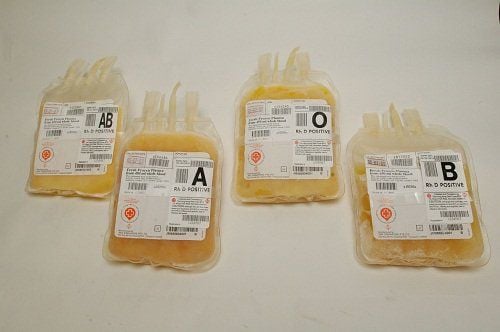
Bệnh nhân rối loạn đông máu bẩm sinh sẽ được chỉ định truyền huyết tương tươi đông lạnh
4. How to use cold precipitator
Each cryoprecipitate unit is approximately 20 to 30ml containing coagulation factors VIII, fibrinogen and Von Willebrand.Cryoprecipitation has a more specific indication than fresh frozen plasma in hemophilia A, fibrinogen deficiency, coagulation factor XIII deficiency, and Von Willebrand disease.
In short, from whole blood collected from blood donors, hematologists will prepare different blood products with different uses of blood. Because blood is a special "biological medicine", both precious and rare, blood transfusions need to be performed according to indications to achieve the highest therapeutic effect.
MORE:
How to classify blood group Basic principles of blood transfusion The role of determining blood group before blood transfusion Rh factor blood test




